| Carex asynchrona | |
|---|---|
| Scientific classification | |
| Kingdom: | Plantae |
| Clade: | Tracheophytes |
| Clade: | Angiosperms |
| Clade: | Monocots |
| Clade: | Commelinids |
| Order: | Poales |
| Family: | Cyperaceae |
| Genus: | Carex |
| Species: | C. asynchrona |
| Binomial name | |
| Carex asynchrona Naczi | |
| Carex asynchrona | |
|---|---|
| Scientific classification | |
| Kingdom: | Plantae |
| Clade: | Tracheophytes |
| Clade: | Angiosperms |
| Clade: | Monocots |
| Clade: | Commelinids |
| Order: | Poales |
| Family: | Cyperaceae |
| Genus: | Carex |
| Species: | C. asynchrona |
| Binomial name | |
| Carex asynchrona Naczi | |

The Cyperaceae are a family of graminoid (grass-like), monocotyledonous flowering plants known as sedges. The family is large, with some 5,500 known species described in about 90 genera, the largest being the "true sedges" genus Carex with over 2,000 species.
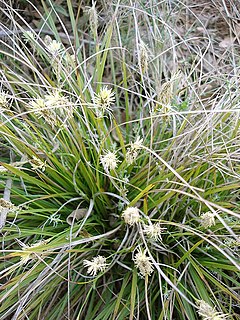
Carex is a vast genus of more than 2,000 species of grass-like plants in the family Cyperaceae, commonly known as sedges. Other members of the family Cyperaceae are also called sedges, however those of genus Carex may be called true sedges, and it is the most species-rich genus in the family. The study of Carex is known as caricology.

Carex vesicaria is an essentially Holarctic species of sedge known as bladder sedge, inflated sedge, and blister sedge. It has been used to insulate footwear in Norway and among the Sami people, and for basketry in North America.

Carex cryptolepis, known as northeastern sedge, is a North American species of sedge first described by Kenneth Mackenzie in 1914.
Carex gunniana is an Australia species of sedge that was first described in 1845 by Boott in the Proceedings of the Linnean Society of London. It is native to eastern Australia and Tasmania.

Carex lanceolata is a species of sedge, native to the eastern half of China, Mongolia, eastern Siberia, Korea, Sakhalin, and Japan. Its seeds are dispersed by ants.
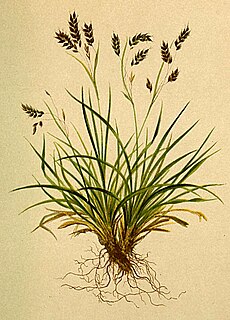
Carex capillaris, the hair-like sedge, is a species of sedge found in North America and northern Eurasia.

Carex viridula, known as little green sedge, green sedge, or greenish sedge, is a small flowering plant native to North America, Europe, Asia, and Morocco.

Carex appalachica is a species of sedge. It is native to the United States and Canada.
Carex argyrantha is a species of sedge and is native to the eastern US and Canada.
Carex atlantica is a species of sedge.
Carex bella is a species of sedge and is native to the US and Mexico.
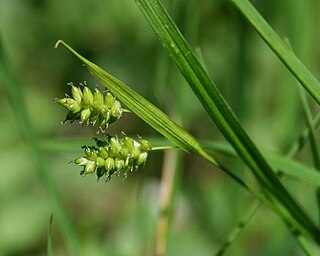
Carex pallescens, called pale sedge, is a widespread species of flowering plant in the genus Carex, native to the northeastern United States, eastern Canada, Iceland, Europe, Tunisia, and western Asia. It has unstable chromosome numbers.

Carex stipata, variously called the prickly sedge, awl-fruited sedge, awlfruit sedge, owlfruit sedge, swamp sedge, sawbeak sedge, stalk-grain sedge and common fox sedge, is a species of flowering plant in the genus Carex, native to Canada, the United States, China, Korea, Japan, and Far Eastern Russia. It is a wetland obligate.
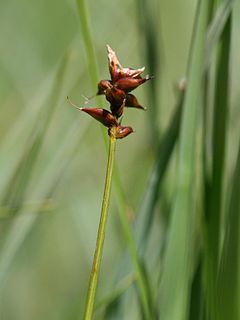
Carex dioica, the dioecious sedge, is a species of flowering plant in the genus Carex, native to Iceland, the Faroes, Svalbard, nearly all of Europe, western Siberia, and the Altai. It prefers to live in calcareous fens.

Carex divulsa, the grey sedge, is a species of flowering plant in the genus Carex, native to Macaronesia, Europe, northwest Africa, the Caucasus region, and the Middle East as far east as Turkmenistan. It has been introduced to northeast Argentina, the District of Columbia and Pennsylvania in the United States, Ontario in Canada, the North Island of New Zealand, and Tasmania and Victoria in Australia. It is the namesake of the Carex divulsa aggregate.

Carex hostiana, the tawny sedge, is a species of flowering plant in the genus Carex, native to Europe and northeast Canada, and extinct in Massachusetts. It is a member of the Carex flava species complex.

Carex supina, called the weak arctic sedge, is a species of flowering plant in the genus Carex, native to Alaska, western and central Canada, Minnesota, Greenland, central and eastern Europe, the Caucasus region, Central Asia, Siberia, the Himalaya, the Amur region, Manchuria, and Korea. It is often found in association with Festuca altaica and Poa glauca.
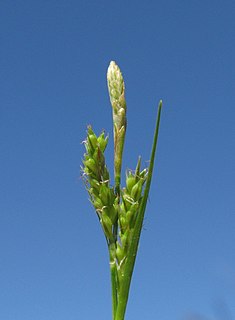
Carex breviculmis, called the Asian shortstem sedge, is a species of flowering plant in the genus Carex, native to Asia from the Indian subcontinent to Southeast Asia, China, Taiwan, Korea, Japan, north as far as Khabarovsk Krai, and Malesia, New Guinea, Australia, Norfolk Island and New Zealand. It has been introduced to the US state of Mississippi. Typically found in forests, it is quite shade tolerant.

Carex lachenalii, called the twotipped sedge and hare's foot sedge, is a species of flowering plant in the genus Carex, native to temperate and subarctic North America, Greenland, Iceland, Europe, and Asia, and the South Island of New Zealand. Its chromosome number is 2n=64, with some uncertainty.
| This Carex article is a stub. You can help Wikipedia by expanding it. |